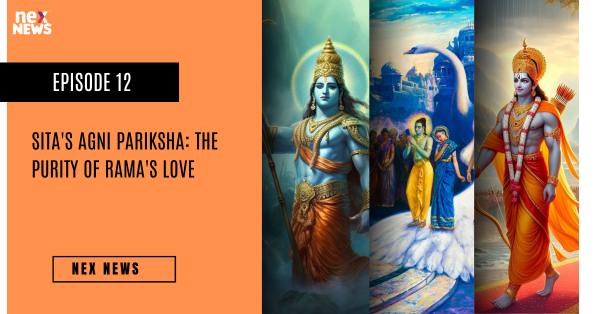The Ramayana, an ancient Indian epic, unfolds a celestial narrative of love, duty, and cosmic battles. At the heart of this epic saga is a moment of profound significance—Sita's Agni Pariksha, or trial by fire. The narrative, interwoven with divine principles, poses questions about purity, righteousness, and the unwavering love between Lord Rama and Sita. In this article, we delve into the layers of Sita's Agni Pariksha, exploring its context, symbolism, and the deeper meaning it imparts about the purity of Rama's love.
The Abduction of Sita: A Cosmic Catalyst
The story of Sita's Agni Pariksha begins with the abduction of Sita by Ravana, the demon king of Lanka. The virtuous and devoted wife of Lord Rama, Sita undergoes a traumatic separation as she is forcibly taken to Lanka, setting the stage for a cosmic drama that will test the limits of love and virtue.
Ravana's treacherous act becomes a catalyst for Rama's divine mission—to rescue Sita and uphold the principles of dharma (righteousness). The abduction sets in motion a series of events that will culminate in the triumph of virtue over evil, but not without subjecting Sita to trials that transcend the mortal realm.
Rama's Unwavering Love: The Pillar of Dharma
At the heart of the Ramayana is the character of Lord Rama, the seventh avatar of Lord Vishnu. His love for Sita is depicted as pure, unwavering, and transcendent. Rama's adherence to dharma and his commitment to righteousness form the pillars upon which the narrative unfolds.
Despite the challenges posed by Sita's abduction, Rama's love remains steadfast. His journey to Lanka, the alliance with the Vanara Sena, and the ultimate confrontation with Ravana reflect the divine prince's unyielding dedication to rescuing his beloved wife and restoring cosmic balance.
The Construction of Rama Setu: A Symbolic Bridge
Before delving into the Agni Pariksha, it is essential to understand the context leading up to this pivotal moment. To reach Lanka, Rama and the Vanara Sena, led by Hanuman, construct the Rama Setu—a bridge built over the ocean with the help of Nala and Neela, skilled engineers in the monkey army.
The construction of Rama Setu is more than a physical feat; it symbolizes the bridge between devotion and divinity, the connection between the mortal and the celestial. The bridge, constructed with stones bearing Rama's name, becomes a testament to the unwavering faith and devotion of the Vanara Sena in their divine mission.
Sita's Stay in Lanka: A Test of Virtue
While in Lanka, Sita faces trials that test her virtue, strength, and devotion. Despite Ravana's attempts to coerce her into submission, Sita remains resolute in her commitment to Rama. Her stay in the Ashoka Grove becomes a period of unwavering faith, prayer, and an unshakable belief in the eventual triumph of righteousness.
It is during this time that Hanuman, in his heroic reconnaissance mission, discovers Sita and conveys Rama's message, providing solace to the captive princess. Sita's virtue shines through her steadfastness, unwavering faith, and unbroken connection to Rama, even in the face of adversity.
The Agni Pariksha: A Trial by Fire
The climax of Sita's trials occurs when Rama, having vanquished Ravana and rescued Sita, is confronted with doubts about her purity. The demon king's malevolence and Sita's prolonged captivity lead some in Rama's kingdom to question her chastity, casting a shadow on her virtue.
To dispel the doubts and prove her purity, Sita undergoes the Agni Pariksha, a trial by fire. In a dramatic and symbolic act, she walks into the flames, calling upon Agni, the fire god, to bear witness to her innocence and purity.
Symbolism of the Agni Pariksha
Purity Beyond Doubt:
The Agni Pariksha serves as a powerful symbol of Sita's purity. The fire, traditionally associated with purity and transformation, becomes a divine witness to Sita's unwavering virtue. Her emergence unscathed from the flames reaffirms her innocence and devotion to Rama.
Divine Justice:
The trial represents a moment of divine justice, where the celestial elements themselves become the arbitrators of truth. The Agni Pariksha underscores the notion that purity, when genuine and untarnished, transcends worldly doubts and judgments.
Sita's Inner Fire:
Sita's walk into the fire is not only a trial but also an assertion of her inner strength and purity. The flames, rather than causing harm, become a transformative medium, symbolizing Sita's enduring connection to Rama and her unwavering faith in their love.
Rama's Dilemma:
Rama's role in the Agni Pariksha reflects his internal conflict. As a ruler, he is bound by the expectations of his subjects, yet as a husband deeply in love with Sita, he grapples with the pain of subjecting her to such a trial. His acceptance of Sita's purity and the eventual reunion underscores the purity of their love.
Reaffirmation of Dharma:
The Agni Pariksha becomes a reaffirmation of dharma and righteousness. Sita's purity and the divine intervention in the trial emphasize the alignment of their actions with cosmic order and the principles of justice.
Reunion and Departure: The Transcendence of Love
Sita's emergence from the Agni Pariksha unscathed reaffirms her purity to Rama and the world. However, the trials faced by Sita take a toll on her spirit. Despite Rama's acceptance of her purity, societal doubts and his duty as a king lead to a heartbreaking separation.
Sita, pregnant with Rama's children, seeks refuge in the hermitage of Sage Valmiki. Here, she gives birth to Lava and Kusha, twins who would later play crucial roles in the Ramayana. The final reunion between Rama and Sita, orchestrated by the divine sage Narada, emphasizes the transcendence of their love beyond mortal comprehension.
Sita, having proven her purity and endured the trials, returns to the earth from which she emerged. The Earth Goddess, personified as Sita, receives her daughter back into her embrace. The separation serves as a poignant narrative, highlighting the ephemeral nature of mortal existence and the enduring purity of their love.
Lessons from Sita's Agni Pariksha
The Agni Pariksha imparts profound lessons that resonate with individuals navigating the complexities of relationships, love, and virtue:
Unwavering Devotion:
Sita's unwavering devotion to Rama, even in the face of adversity, exemplifies the transformative power of love. Her actions become a testament to the enduring strength of love that transcends doubts and challenges.
Divine Justice and Purity:
The Agni Pariksha underscores the concept of divine justice and the purity that transcends worldly judgments. Sita's trial becomes a symbolic act, emphasizing the importance of purity of heart and intention.
Dharma in Relationships:
The dilemma faced by Rama in subjecting Sita to the trial raises questions about the complexities of dharma in relationships. The narrative invites contemplation on the balance between individual emotions and societal expectations.
Inner Strength in Adversity:
Sita's walk into the fire represents her inner strength and resilience in the face of trials. The flames become a metaphor for transformative power, symbolizing the capacity of the human spirit to endure and emerge stronger from challenges.
Transcendence of Love:
The separation and eventual reunion between Rama and Sita highlight the transcendence of love beyond mortal existence. Their love becomes a timeless symbol of purity, sacrifice, and the enduring connection that transcends the boundaries of life and death.
Conclusion
Sita's Agni Pariksha stands as a poignant chapter in the Ramayana, inviting contemplation on the nature of love, virtue, and the complexities of mortal existence. The trial by fire becomes a symbol of purity, justice, and the enduring strength of love between Rama and Sita.
As individuals navigate the complexities of their own relationships and face trials in life, the lessons from Sita's Agni Pariksha offer insights into the transformative power of unwavering devotion, the pursuit of righteousness, and the enduring purity that resides within the human heart. In the cosmic drama of the Ramayana, Sita's Agni Pariksha becomes a timeless reminder that love, when rooted in virtue and divine principles, has the power to transcend even the most challenging trials.

